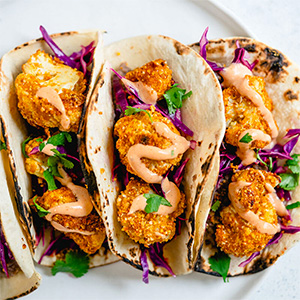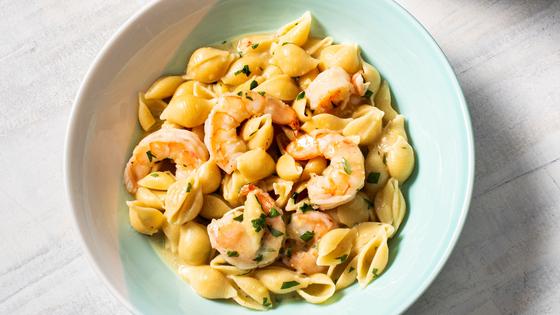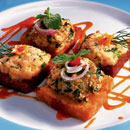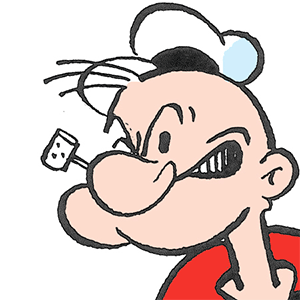This flavorful pasta dinner is ‘shrimp-ly’ delicious!
Shrimp is the most popular seafood in the United States. These slightly sweet, mild-flavored crustaceans are full of interesting science. Take a deep dive into these shrimp-ly fascinating facts.
Shrimp change color when they cook
Most raw shrimp are a gray-black color. But when you cook them, they turn pink! Why the color change? Shrimp contain a pigment called astaxanthin (“ah-stuh-ZAN-thin”) that is released when the shrimp reach about 120 degrees. Bonus fishy fact: Salmon have pink flesh because they eat shrimp and krill, a shrimp relative that contains the same pigment.
Shrimp come in lots of sizes
There are about 2,000 species of shrimp around the world, and humans eat around 300 of them — from common whiteleg shrimp to beautiful royal red shrimp. Some species are harvested when they’re super tiny, dried and used in all sorts of dishes, including soups, salads, and stir-fries. On the other hand, black tiger shrimp can grow as long as 13 inches!
The shell is full of flavor
Shrimp shells contain proteins, sugars, and compounds called glutamates (“GLUE-tah-mates”) and nucleotides (“NEW-clee-oh-tides”), which have a savory umami taste. If you cook shrimp shells, their proteins and sugars undergo a special chemical reaction that gives them even more flavor. But peeling shrimp is A LOT of work! In this recipe, we use peeled shrimp and add another ocean ingredient — clam juice — to boost this dish’s salty seafood flavor.
One-Pot Garlicky Shrimp Pasta
Serves 4
1 pound frozen peeled and deveined extra-large shrimp (21 to 25 per pound), thawed and tails removed
1/8 teaspoon pepper
1/2 teaspoon plus 3/4 teaspoon salt, measured separately
1 tablespoon plus 2 tablespoons extra-virgin olive oil, measured separately
6 to 8 garlic cloves, peeled and minced
1/8 teaspoon red pepper flakes
3 cups water
2 cups chicken broth
1/2 cup clam juice
4 1/2 cups medium pasta shells (12 ounces)
1/2 teaspoon grated lemon zest plus 2 tablespoons juice, zested and squeezed from 1 lemon
2 tablespoons chopped fresh parsley
1. In a medium bowl, combine shrimp, pepper, and 1/2 teaspoon salt. Stir until shrimp are evenly coated.
2. In a Dutch oven, heat 1 tablespoon oil over medium-high heat for 2 minutes (oil should be hot but not smoking). Add shrimp to pot and spread in a single layer. Cook shrimp, without stirring, until edges turn pink, about 1 minute.
3. Stir shrimp and cook until pink all over, 30 seconds to 1 minute. Turn off heat. Transfer shrimp to a large plate.
4. Add garlic, red pepper flakes, and the remaining 2 tablespoons oil to the pot. Cook over low heat, stirring often with clean rubber spatula, until garlic is just beginning to turn golden, 4 to 6 minutes.
5. Stir in water, broth, clam juice, pasta and remaining 3/4 teaspoon salt. Increase heat to medium-high and cook, stirring often, for 12 minutes.
6. Continue cooking, stirring constantly and scraping the bottom of the pot, until pasta is tender and sauce is thickened, 3 to 8 minutes longer. Turn off heat. (Sauce will continue to thicken as it cools.) Stir in lemon zest and juice, parsley and shrimp. Let sit until shrimp is heated through, 1 to 2 minutes. Serve.
(For 25 years, home cooks have relied on America’s Test Kitchen for rigorously tested recipes developed by professional test cooks and vetted by 60,000 at-home recipe testers. The family of brands — which includes Cook’s Illustrated, Cook’s Country, and America’s Test Kitchen Kids — offers reliable recipes for cooks of all ages and skill levels. See more online at www.americastestkitchen.com/TCA.)
©2022 America’s Test Kitchen. Distributed by Tribune Content Agency, LLC.










Comments